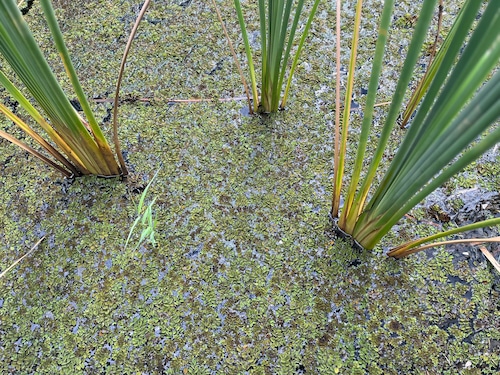A giant floating fern that carpets waterways with thick, leafy mats has become a major problem in Alabama waterways.
It’s called Giant Salvinia.
“Nobody wants it,” said Monica Allen, a spokesperson for the Mobile Area Water and Sewer System.
“It’s hard to knock it back without threatening other things in the ecosystem,” said Laura Frost, a biologist with the University of South Alabama..
In 1999, experts say, the plant was first discovered in Alabama in two ponds in Auburn.
Today, in southwest Alabama, the Washington County Public Fishing Lake is currently closed to kill off Giant Salvinia. The Alabama Department of Conservation and Natural Resources will draw down the lake and keep it closed through the winter.
For nearly a year between 2021 and 2022, Big Creek Lake near Mobile was closed as MAWSS tried to root out Giant Salvinia. When the lake reopened to recreation, the rules were much stricter: boaters must wash their boat before entering the lake and can only use the lake on weekends.
“Salvinia grows amazingly fast,” said Allen at MAWSS. It disrupts the entire ecosystem.”
Trying to control the spread of Giant Salvinia in Big Creek Lake is one of the biggest challenges for MAWSS, Allen said.
“We have to monitor it,” she said, “and let the science take us where it goes.”
The lake was closed to recreation for so long, Allen said, because the utility had to wait for cooler temperatures in the winter to kill the plant. But it may be a battle without end. In 2022, MAWSS Director Bud McCrory told Alabama Living magazine that the lake will never be completely rid of Giant Salvinia, and simply has to mitigate its spread.
Members of the Mobile City Council have expressed concern about the Giant Salvinia in the lake, which is the primary source of drinking water for 70% of Mobile County residents, as a possible reason for the city of Mobile to annex the lake.
So what is Giant Salvinia? And why has it become such a challenge for Alabama?
Giant Salvinia is native to parts of Brazil, Colombia and Guyana in South America. It was introduced through Texas and Louisiana, though it’s now a problem throughout the Gulf Coast, said Frost, who teaches biology at the University of South Alabama. The fern creates large mats over the surface water that look like green carpet.
It was discovered in those two ponds in Auburn, which drain into the Tallapoosa River watershed, according to ADCNR. But since then, it has been found in 16 watersheds throughout the state, including Mobile Bay and Wheeler Lake, according to the U.S. Geological Survey.
As of 2018, the plant was eradicated in northern Alabama, according to the U.S. Fish and Wildlife Service, though USGS records show that it was observed in the Wheeler Lake watershed in 2021 and 2022.
The plant’s mats block needed sunlight for aquatic plants that live below the water’s surface, Frost said.
Giant Salvinia can be devastating for the water quality. When the plant’s mats begin to die, the decomposing Salvinia sinks to the bottom of the water, consuming dissolved oxygen as it dies. That threatens fish and other marine animals, which need dissolved oxygen to live.
The fern’s ability to harm other marine life is precisely what makes it so dangerous in the southeast, Frost said. Almost all of Alabama is part of the “North American Coastal Plain,” a region that stretches from northern Mexico, along the Gulf Coast and up the East Coast to Southeastern Massachusetts.
The North American Coastal Plain is known throughout the world as a hotspot of biodiversity. But Giant Salvinia is a threat to that.
“When an invasive species has the ability to take up that biodiversity, it’s a threat to the region,” Frost said.

A mat of Giant Salvinia covering the surface water. The fern blocks sunlight from reaching aquatic plants under water. (Photo courtesy Laura Frost)Laura Frost
And though the giant salvinia spores are sterile, meaning it typically can’t reproduce sexually, the plant is very successful at reproducing clonally, Frost said, creating the dense mats of green leaves on the water surface.
This rapid, clonal reproduction is part of how the plant is able to spread so easily. A few leaves can stick to a boat or a water bird; when that vessel hits another body of water, the leaves are transferred into that water and start building there. Pieces of Giant Salvinia mats can float downstream from a tributary to a larger body of water.
In good conditions, the plant’s biomass—the quantity of the plant in a given area—can double in a week to 10 days, according to the U.S. Fish and Wildlife Service. In ideal conditions, the plant’s area can double in eight days, Frost said.
Once it’s in the water, Giant Salvinia can be difficult to get rid of, Frost said. Its only real threat is freezing weather, something that’s a rarity in the southeast. Herbicides can be effective, but Frost said that Salvinia can develop resistance to those. Herbicide use can also inadvertently harm the water quality, as the dying plants release nutrients or fertilize new growth.
One way that countries have been able to get rid of Giant Salvinia is by deploying a special kind of insect, called the salvinia weevil, that eats the buds and young shoots of the plant. The weevil is native to the same tropical region as Giant Salvinia; countries like Papua New Guinea, Fiji and South Africa have been able to successfully control the plant with the salvinia weevil, Frost said.
In order to prevent the spread of Giant Salvinia, boaters should remove any aquatic plants from their equipment before leaving a launch area, Frost said, and wash their boats before entering a new waterway, as users of Big Creek Lake are now required to do.
Dave Armstrong, an aquatic nuisance species coordinator with the Alabama Department of Conservation and Natural Resources, previously told AL.com that boaters should be careful not to throw away Giant Salvinia in the wild.
“Don’t throw them out in the wild or even in a subdivision pond,” Armstrong told AL.com. “Put them in your mulch pile and keep them within the confines of your home ownership area. Because throwing them out in the wild just spreads the problem.”
Source link : http://www.bing.com/news/apiclick.aspx?ref=FexRss&aid=&tid=66f3f223c4ca4b3e92c0844c5eb42403&url=https%3A%2F%2Fwww.al.com%2Fnews%2Fmobile%2F2024%2F09%2Fthis-giant-floating-fern-is-taking-over-the-lakes-in-south-alabama.html&c=359836711735080866&mkt=en-us
Author :
Publish date : 2024-09-25 00:01:00
Copyright for syndicated content belongs to the linked Source.






